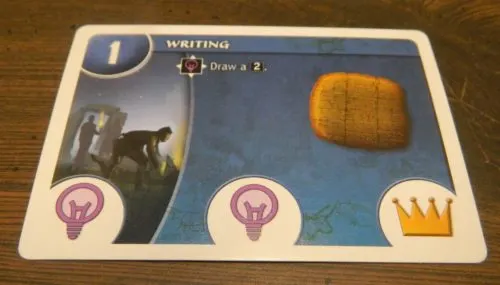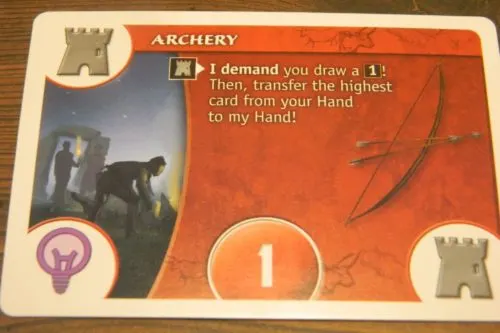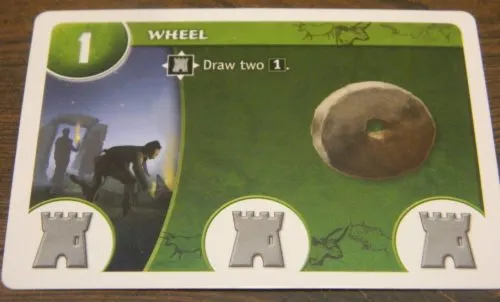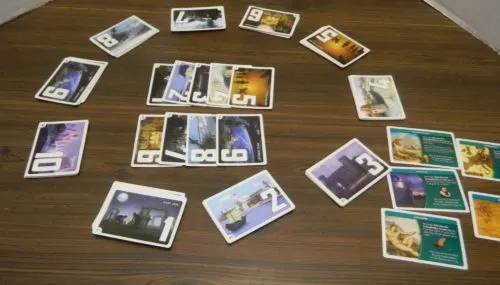A theme that I have always found intriguing for both video and board games is the civilization building theme. I have always enjoyed the Civilization series of video games and I have been looking for a good civilization building board game for quite some time. I have played some solid games that utilize the theme but I have never played a truly great civilization building board game. I was hoping today’s game, Innovation, would change that as it currently sits as one of the best 300 board games of all time on Board Game Geek. The problem with most civilization building games is that they are usually overly complicated. Innovation defies that trend by streamlining the theme down to its basics in order to create a simple and straight to the point card game. While it relies on a little too much luck and has a leader problem, Innovation is a great example of streamlining the civilization building theme into a card game that maintains the strategy while remaining accessible.
How to Play Innovation
Setup
- Separate the cards into 10 draw piles based on the the number on the back of the cards (their period). Shuffle each set of cards and place them in a circle in the center of the table.
- Take the top card from periods 1-9. These cards are placed face down in the center of the circle.
- Place the domain cards to the side of the circle.
- Each player takes a gameboard and two cards from the first period. Each player chooses one of the two cards to play. This card is played face up in front of them. The other card remains in their hand.
- The first player is determined by the card each player chose to play. The player who played the card first in alphabetical order gets to start the game. The first player will only get one action on their first turn. Play then continues clockwise.
Playing the Game
On a player’s turn they will get to take two actions. They can either choose two different actions or repeat the same action twice. The potential actions you can take in the game are as follows:
- Draw a Card
- Play a Card
- Activate a Card
- Dominate
Drawing a Card
As there are no limits on the number of cards you can have in your hand, you can always use an action to draw a card. When you draw a card you must draw it from the period of the highest card that you have played in front of you. For example if you have played a period two card, you can no longer draw period one cards with the draw action (you still may be able to take a period one card due to a card’s dogma). If all of the cards from your current period are gone, you must draw a card from the next period.

This player has drawn the writing card. The card is a blue card so it will be added to or will start the blue pile if it is played. It provides two “light bulb” symbols and one “crown”. The card’s dogma gives the player a 2 card when it is activated.
Playing A Card
For one action you are able to play one of the cards from your hand to the table. Each card in the game is of a particular color. If you have already played a card of the same color in the past, you must place the new card on top of the previously played card. If you have not already played a card of the color, you begin a new pile for the color. Cards do not have to be played in any numerical order so you can play a one card on top of a five card if you want to.

This player has played their second blue card “Tools”. This card will be played on top of “Writing”.
When adding to a pile that has already been “splayed” (see below), you will also splay the new card in the same way.
Activate A Card
A player can choose to activate one of their active cards (the card on the top of a pile) for one of their actions. Activating a card does not use up the card as you can activate the same card twice on your turn. To start using a card you need to tell the other players which card you are using. Once a card has been activated, you will read and implement all of the actions/dogmas on the card that apply.
To figure out which players a dogma will impact, each player counts up how many of the symbol shown next to the action they have. The players count up all of the matching symbols that are visible on their active cards or through splaying (see below).

For determining whether dogmas will apply to this player, they have the following symbols: three “light bulbs”, seven “castles”, two “crowns”, and one “tree”.
For each dogma on the card you must first determine which players will be affected. Each affected player has to follow a dogma unless it begins with “I may” There are two different types of dogmas on the cards.
First are supremacy dogmas which feature a symbol with an arrow pointing to the right and text beginning with “I demand”. Every player that has less of the corresponding symbol than the current player has to follow the action. If this impacts more than one player, start with the affected player closest to the left of the current player and proceed clockwise.

This card features a supremacy dogma. All players who have less “castles” than this player will have to follow the action on the card.
The other type are cooperative dogmas. Cooperative dogmas are shown with arrows pointing in all four directions from the symbol. Anyone who has as many or more of the corresponding symbol as the current player, will perform the dogma along with the current player. Qualified players follow the dogma starting with the player to the left of the current player moving clockwise with the current player following the dogma last. If at least one player other than the current player is able to take advantage of the dogma, the current player gets to draw a card (for free) once the card has been fully resolved.

This card has a cooperative dogma. When activated all of the players that have the same or more “castles” than the player who controls the cards will get to draw two 1 cards.
One unique impact of some dogmas allows players to “splay” their cards. Cards can either be splayed up, left or right. When you splay a group of cards you will fan them out which allows you to see and use symbols on cards that have been covered up. A pile that only has one card cannot be splayed.

These three piles of cards have been “splayed”. The cards on the left have been splayed up. The middle cards are splayed right. The cards on the right are splayed left.
Some other special effects from dogmas include:
- Archive: Place the card on the bottom of its corresponding color pile. If you don’t have a pile for the color, the card forms a new pile.
- Draw and: When a card says this, you must do the action after “and” with the card you just drew.
- Exchange: Trade one of your cards for a card from the other player.
- Discard: A card that is discarded is removed from the game.
- Recycle: When a card is recycled, it is placed face down at the bottom of its corresponding period pile in the middle of the table.
- Score: Flip the card face down and put it under the left side of your gameboard. Scored cards are worth influence points equal to their period number.
Dominate
The final action that a player can take is to dominate a period. To dominate a period a player has to use one of their actions and meet two requirements:
- A player needs to have influence points equal to the value of the period they want to dominate times five. For example to dominate period three, you need 15 influence points. You gain influence points throughout the game by “scoring” cards.
- You must have an active card that is equal to or higher than the period you want to dominate. For example if your highest card is a period five card, you can dominate periods 1-5.
When a player dominates a period, they take the corresponding card from the center of the table. They place this card under the right side of their board but they don’t look at what is on the other side of the card. When you dominate a period, you do not lose any of the influence points used to acquire it. Once an age has been dominated, it cannot be taken by another player.
In addition to dominating periods, players can dominate various domains. To dominate a domain you don’t need to use an action as you acquire the card whenever you meet the requirements on the card. When a player meets the requirements on one of the domain cards, they place it to the right side of their gameboard. If the domain is earned through a cooperative dogma, the first player to acquire it gets to keep it. If two players would acquire the card at the exact same time, the active player or the tied player closest to their left gets to take the domain card.

In order to dominate this domain you either need to have an eight for each active card or you can dominate through the astronomy card.
End of Game
Innovation can end in a couple different ways.
If a player ever acquires a certain number of dominations (periods and/or domains), they automatically win the game. The number of dominations needed to win the game depends on the number of players:
- 2 players: 6 dominations
- 3 players: 5 dominations
- 4 players: 4 dominations
The game will end whenever a player is forced to draw a card from the eleventh period (which doesn’t exist) or a dogma says that “the game ends”. Each player counts up how much influence they have. The player with the most influence wins the game. If there is a tie, the tied player with the most dominations wins the game. If there is still a tie, the tied players share the victory.
In periods eight, nine and ten there are a few cards that can immediately win you the game. If a player is able to activate one of these cards, the player automatically wins the game.
My Thoughts on Innovation
I think the best way to describe Innovation is to think of what you would get if you broke down a civilization building game enough to fit inside a card game. Instead of wasting time with a bunch of unnecessary rules, the game focuses on what matters most: the gameplay and just having fun.
Like most card games the main gameplay revolves around drawing, playing and activating cards. This by itself sounds like many other card games. What truly makes Innovation original is what you can do with the cards once you activate them. Every card in the game has one or more actions that you can perform once you activate the card. These actions can range from drawing cards, scoring cards, and even taking cards from other players. This aspect of the game is critical as it is responsible for pretty much all of the strategy in the game.
Basically the goal in Innovation is to try and figure out the best way to use the cards that you draw throughout the game. While I believe some cards are better than others (more on this later), each card in the game has some sort of benefit that you can take advantage of or a punishment you can give to your opponents. Figuring out the best way to use these abilities is what is going to decide who wins and loses the game.
While I think the official rules are written kind of poorly, Innovation is not that difficult to play. You basically just choose which two actions you want to take on a given turn; which comes down to drawing, playing or activating a card or dominating an age. On its own none of these actions are difficult at all. You could probably teach the basic gameplay to new players within a couple minutes. Pretty much all of the game’s difficulty comes from figuring out what each card does and how you can use it to help your strategy. Innovation is one of those games that require you to spend a decent amount of time reading through your cards before you decide what to do on a given turn.
For the most part I would say that Innovation is pretty accessible. What I like about the game is that the accessibility doesn’t get in the way of the game’s strategy. While luck plays a role in the game, I would say strategy is usually the determining factor in most games. The decisions you make in the game will determine how successful you are going to be in the game. No amount of good luck is going to make up for making bad decisions. What I like about the strategy in Innovation is that the game gives you quite a bit of flexibility in choosing what you want to do. There are different ways of approaching the game with plenty of decisions to make which will have a lasting impact on the game.
The key to any strategy in Innovation is that you have to be flexible. Innovation has a lot of card effects that allow you to mess with other players which includes taking cards from them. Therefore you can never rely on a specific strategy to last very long. There is quite a bit of take that in the game as you could be humming along and another player can throw a wrench into your plans. I am generally not a big fan of take that games but I don’t mind it as much in Innovation. It sucks when other players mess with your strategy but on the positive side it makes every game feel unique. Unlike some games, there is no way you can rely on the same strategy every game. The player that is able to adjust the quickest will have an advantage in the game.
Ultimately the key to being successful in Innovation is to try and acquire as many “resources” as possible. The player who has access to the most symbols has several benefits over the other players. First a player can avoid a supremacy dogma from another player if they have more of the symbol. As these are pretty much always bad for the affected player(s), being able to avoid them significantly helps you. Having more symbols even helps with the cooperative dogmas. If a player has more of a symbol than the rest of the players, they can activate one of their cards with a cooperative dogma and be the only player that can take advantage of it. At the same time a player with a lot of symbols has a good chance of taking advantage of other player’s cooperative dogmas.
Due to how important the symbols are in the game, the idea of “splaying” is huge in the game. While I think the name “splaying” is pretty stupid, I love the mechanic. Basically splaying allows a player to fan out their cards which gives them access to symbols on cards that otherwise couldn’t be used. You can’t use the abilities on these other cards, but getting access to additional symbols really helps you in the game. I think this mechanic is really clever as it adds a lot to the game without adding a lot of difficulty. A player that is able to splay most or all of their cards is going to have a significant advantage in the game as they could end up with several times more symbols than the other players. If you are unable to ever splay your cards, you are going to have a hard time competing with the other players.
While Innovation supports between two to four players, I am unsure which player count is best for Innovation. We ended up playing the game with only two players. With two players there is a lot of back and forth as players have to focus on building up their own civilization while occasionally messing with their opponent. With only two players the game moves pretty quickly as you don’t have to sit around waiting for all of the other players. I would guess the three and four player games are more free-for-all. Players are able to mess with multiple players at the same time as well as take advantage of several other players’ cards. I see games with more players being more chaotic but that may not always be a bad thing. While three and four player games are going to take longer than two player games, at least Innovation has some player interaction as players have the ability to use abilities from other players’ cards when they are activated.
For the most part I really liked Innovation. It is one of those games that has a good blend of being accessible while still giving players plenty of strategic options. You truly feel like your decisions in the game make a difference. It is really satisfying finding ways to combine your cards together in order to help yourself or hurt your opponent(s). The game even has enough variety that it is unlikely to feel repetitive for quite a while. While I really liked Innovation, I will say that it does have a few issues.
I would say that the biggest issue with the game is the potential for a runaway leader. As I mentioned earlier, having access to a lot more resources than the other players gives you a pretty big advantage in the game. This allows you to take advantage of more cards while avoiding negative cards. Players can gain a big advantage in symbols in a couple different ways. First since you can only have one card active from each color, if you are able to quickly get a card from each color you are going to have an advantage over the other players. A player that is able to take advantage of splaying can also gain a pretty big advantage. The problem is that once a player gains a pretty big symbol advantage over the other players, it is hard to catch back up. Players are more likely to just expand their lead. In most cases this player will just stroll towards an easy victory.
Second Innovation relies on a little more luck than I would have liked. The game doesn’t have a lot of luck, but like most card games there is some card draw luck. Players who draw the right cards at the right times are going to have an advantage in the game. While most of the cards have their own advantage, there are cards that are better than others. If you get the right cards you are going to have an advantage in the game. Every card eventually gets replaced by a better card, but being able to take advantage of an overpowered card early in the game gives you an advantage.
The final issue I had with Innovation is that I wish the game had a better way of handling how you keep track of your symbols and influence. As both are always changing, you regularly have to count them to know where you currently stand. In the case of influence points, you will have to add up a bunch of cards to get your current total. You can’t really replace lower value cards with higher cards as the value on the cards come into play with some of the dogmas. The same thing happens with the symbols. As your symbols can change at any moment, each time a symbol comes up in a dogma you will have to count how many you have. I wish the game could have included some sort of tracker for the symbols and influence that you could update each time you gained or lost symbols/influence. While the counting is not that big of deal, being able to save some time by looking at a tracker would have been helpful.
The component quality of Innovation is going to depend on what version of the game you end up purchasing. For this review I used the 2014 IELLO version of the game. The main difference between the two versions of the game is the quality of the artwork. The versions of Innovation produced by Asmadi Games have pretty basic card design. The cards get straight to the point with little artwork which makes them kind of dull to look at. The newer versions of the game include quite a bit more artwork which looks really nice. Other than the artwork, the gameboards are quite a bit sturdier in the newer versions of the game.
Should You Buy Innovation?
Some people might be a little skeptical of a civilization building game being streamlined down to a card game, but Innovation succeeds at the task. Innovation plays a lot like a typical card game but there is a lot more to it. For the most part you are just drawing, playing and activating cards. The reason that the game succeeds though is due to the cards themselves. Every card in the game can be activated for their effect. The strategy in Innovation comes from figuring out how to combine these card abilities together in order to improve your own position or hurt your opponents. The ultimate goal is to gather as many symbols as possible as it lets you take advantage of more card actions while being able to avoid the negative actions. The idea of splaying is a really clever mechanic as it allows players to fan out their cards giving them access to more symbols. Innovation does a good job of packing a lot of strategy into a game that is quite accessible. The only problems that I had with the game is that it sometimes has a runaway leader problem, there is a little more reliance on luck than I would have liked, and the game could have done something to make it easier to keep track of how many symbols and influence you have.
If you don’t really like card games that rely on you reading and figuring out how to use the abilities on the cards, Innovation is not going to be for you. If you like card games built around trying to maximize the abilities on your cards, you should really enjoy Innovation. I enjoyed Innovation a lot and I would recommend that most people pick it up.
If you would like to purchase Innovation, you can find it online: Amazon, eBay









